Personal Loan Statistics: 2025
According to the latest industry data, 24.8 million Americans collectively owe $257 billion in personal loans. That amounts to a fraction of what’s owed for mortgages, auto loans and credit cards but is proof of the growing popularity of personal loans.
The numbers behind the trends can reveal how borrowers use personal loans — and how they impact consumers’ finances. Explore our personal loan statistics for a more in-depth view.
Key facts
- Americans owe $257 billion in personal loan debt as of the second quarter of 2025, up $4 billion from the previous quarter and $11 billion from a year earlier ($246 billion). That’s a 4.5% jump from the previous year.
- 24.8 million Americans have a personal loan as of Q2 2025, up from 23.9 million a year earlier. That’s a 3.8% year-over-year increase.
- Personal loan debt makes up 1.4% of outstanding consumer debt as of Q2 2025. It accounts for 5.1% of nonhousing consumer debt. To compare, Americans owe $1.209 trillion in credit card debt, which accounts for 6.6% of outstanding debt.
- The delinquency rate (60 days or more past due) for personal loans is 3.37% as of Q2 2025. That’s a minimal decrease from 3.38% a year before.
- The average personal loan debt per borrower is $11,676 as of Q2 2025. A year before, the average debt per borrower was $11,687.
- Almost half of borrowers (47.6%) take out a personal loan to consolidate debt or refinance credit cards. The next-closest reason is for everyday bills (8.8%).
Americans owe $257 billion in personal loan debt
Personal loan borrowers owe $257 billion in debt as of Q2 2025 — up $4 billion from the previous quarter, marking the highest amount in the 19-plus years for which data is available. It’s a 4.5% increase from Q2 2024, when Americans owed $246 billion.
Here’s an overview of the amounts Americans have owed on personal loans over time:
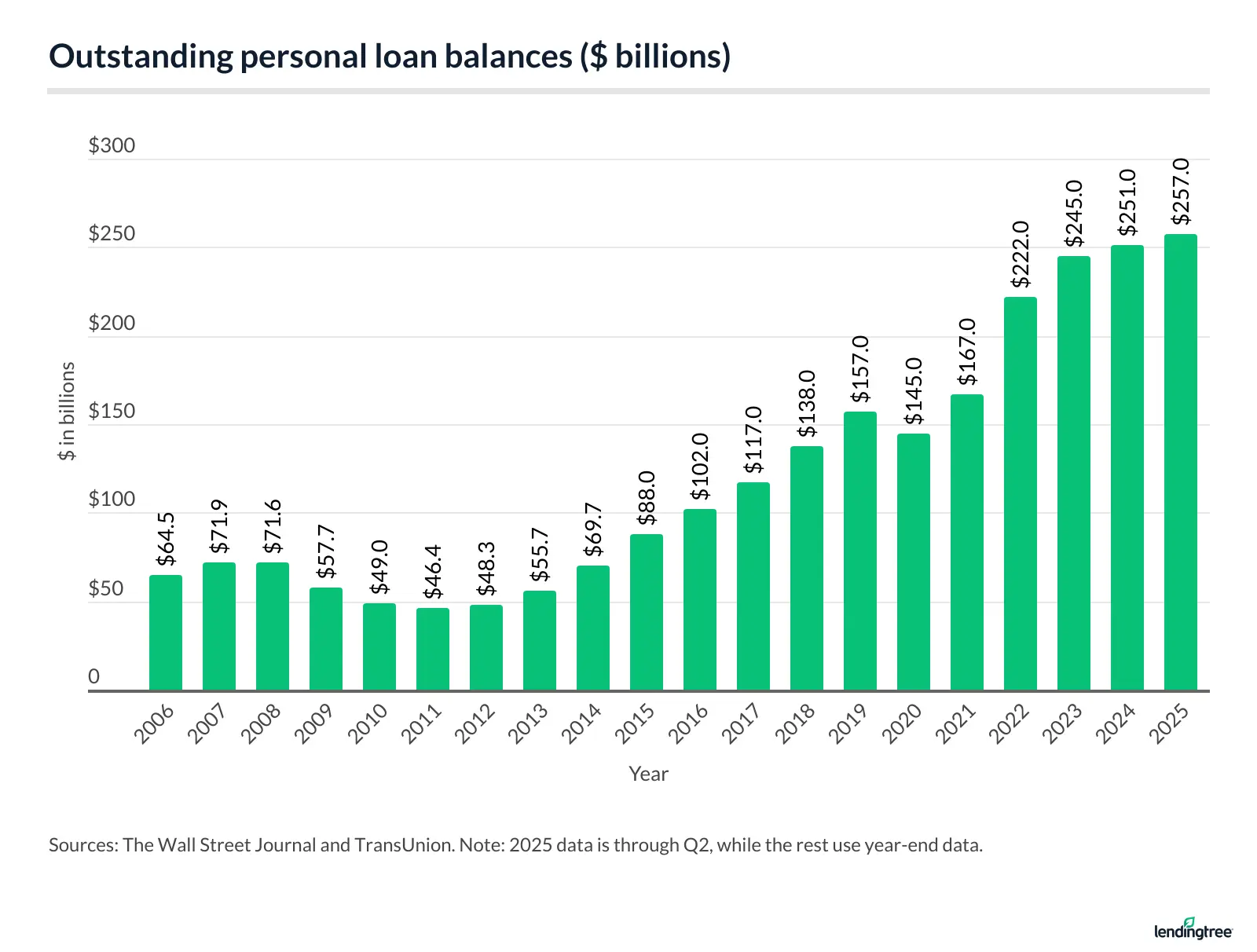
24.8 million Americans have a personal loan
As of Q2 2025, 24.8 million Americans have a personal loan, up from 23.9 million in Q2 2024.
The number of people with loans decreased during the coronavirus pandemic, from a previous high of 20.8 million at the end of 2019 to 18.7 million in Q2 2021. Following that, there were six consecutive increases before the number declined from 22.5 million in Q4 2022 to 22.4 million in Q1 2023. The number has since increased by millions.
Here’s a look at the number of consumers with personal loans dating to 2015:

Personal loan growth returns after dropping early in pandemic
The massive, nearly decade-long rise in personal loan debt ended in 2020, thanks to the pandemic. Personal loan balances fell 7.6% in 2020, marking the first decline since 2011.
But personal loan debt balances spiked 15.2% in 2021, reversing the previous year’s downward movement. Balances in 2024 were up 2.4% year over year.
Here’s a closer look at the ups and downs since 2007:
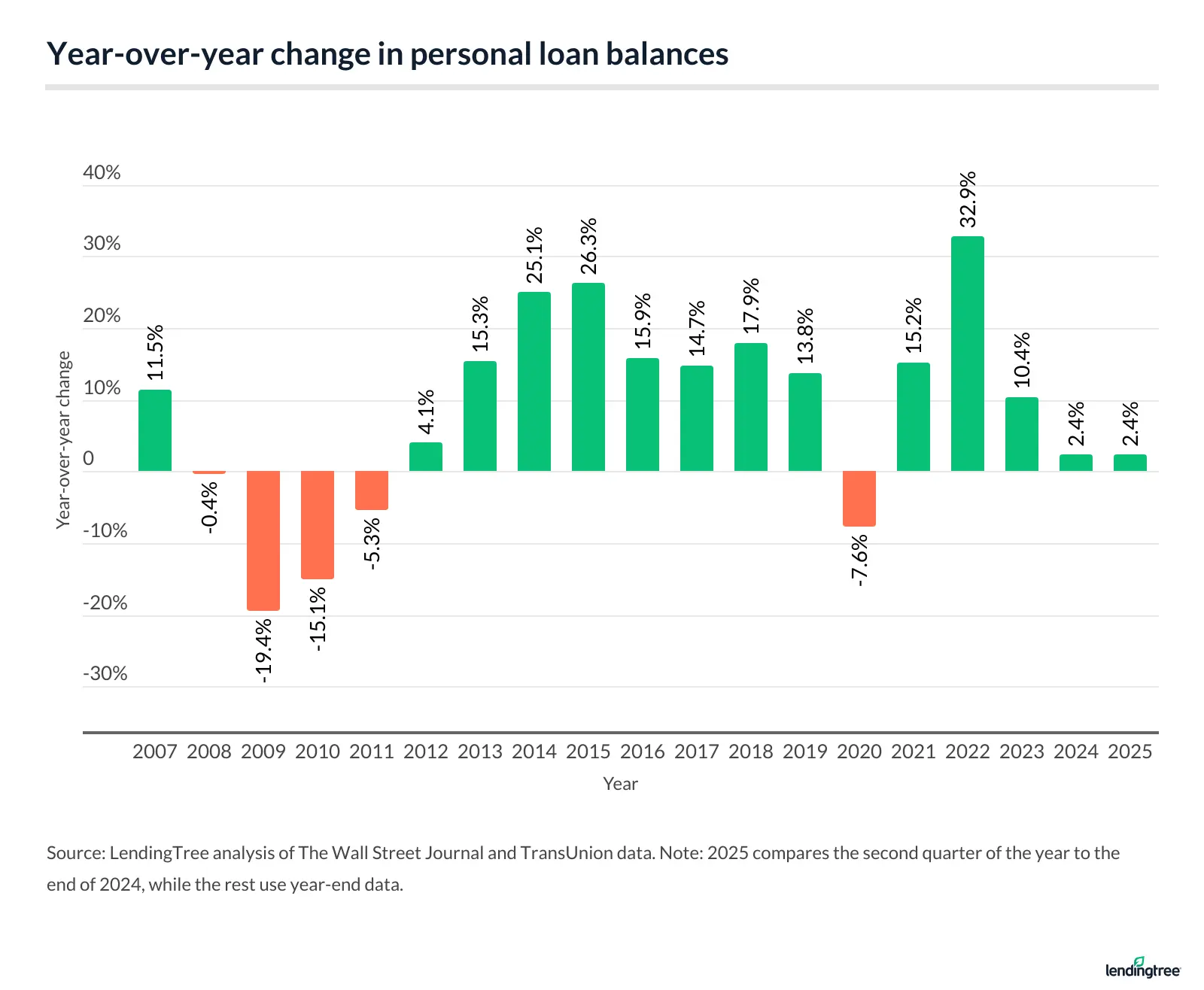
Personal loans account for 1.4% of consumer debt
Personal loans continue to make up the tiniest sliver — 1.4% — of consumer debt held by Americans, despite substantial growth over the past decade.
Comparatively, Americans owe $1.209 trillion in credit card debt, which accounts for 6.6% of their outstanding debt.
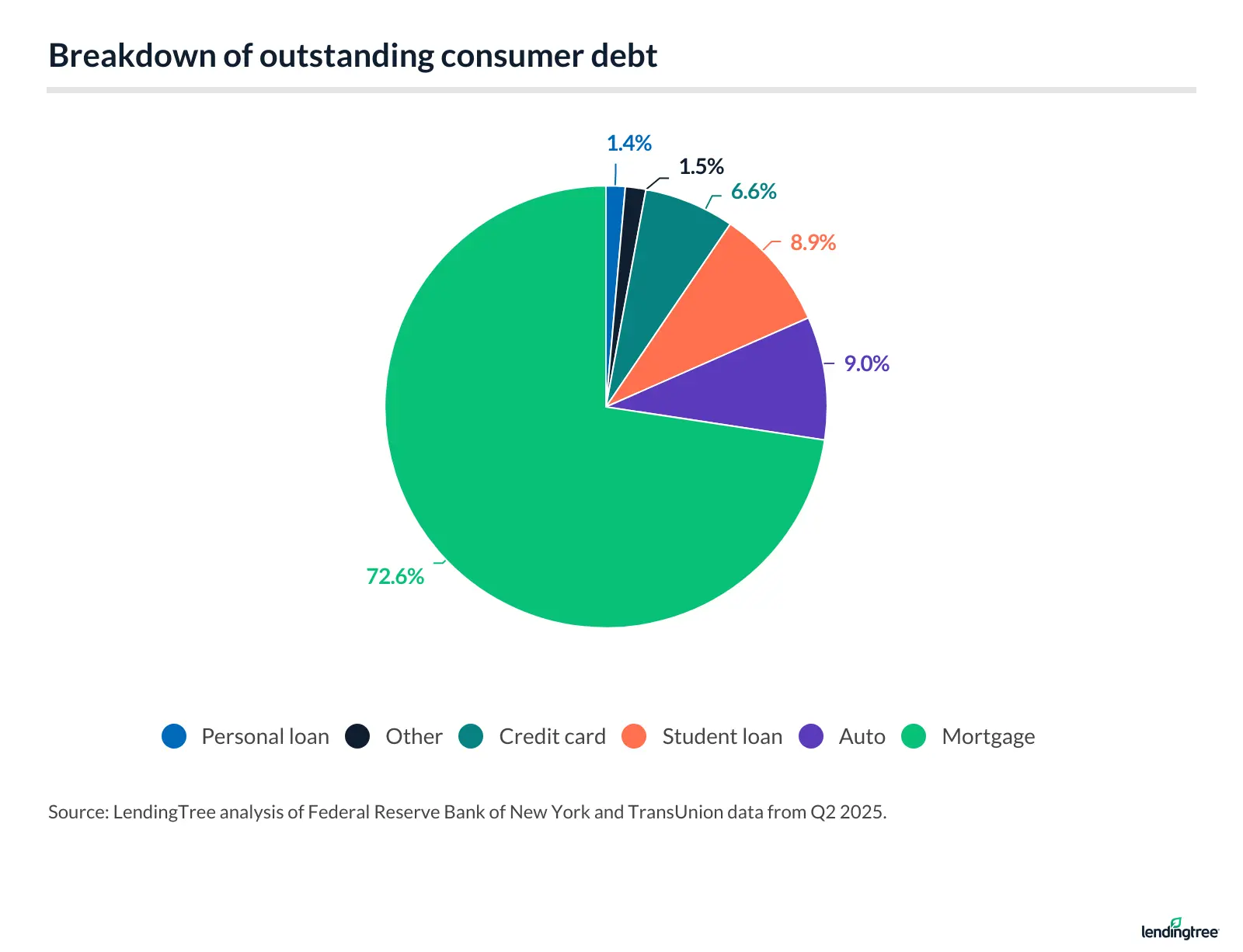
If you remove mortgages from the picture, personal loans account for 5.1% of nonhousing debt.
3.37% of personal loan accounts are 60 days or more past due
An estimated 3.37% of personal loan accounts are 60 days or more past due as of Q2 2025 — a 0.3% decrease from 3.38% in Q2 2024 and a 6.9% decrease from Q2 2023.
Still, that figure is significantly higher than delinquency rates for other common loan types, such as mortgages (1.27%), auto loans (1.49%) and credit cards (2.17%). (Note that credit card delinquencies are tracked at 90 or more days.)
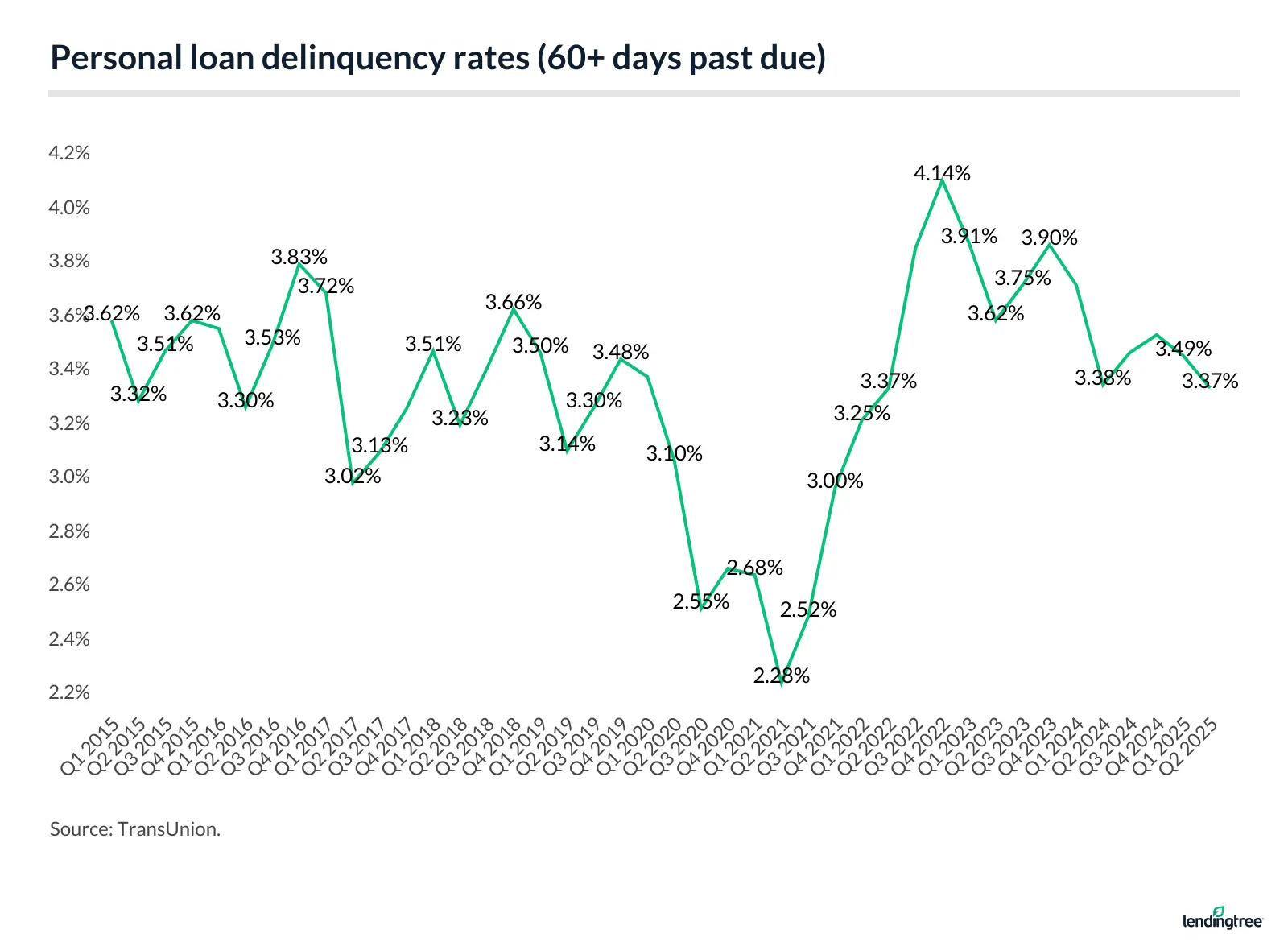
Despite personal loan delinquency rates being high compared to other loan types, it’s interesting to compare today’s figures to the 30-day delinquency rate of 4.77% on consumer loans in 2009 when the Great Recession ended.
Average personal loan debt per borrower is over $11,600 — and the APRs owed
The average personal loan debt per borrower is $11,676 as of Q2 2025. That compares with:
- $11,687 in Q2 2024
- $11,548 in Q2 2023
- $10,344 in Q2 2022
On average, borrowers with credit scores of 680 or higher typically see personal loan APRs that are competitive with the APRs they would receive on credit cards.
The average APR on new credit card offers is 24.36% as of September 2025, with minimum and maximum rates between 20.79% and 27.93%. As the chart below shows, individuals with excellent credit who apply for a personal loan are likely to receive a better rate than those with less favorable credit.
Personal loan statistics by borrower credit score
| Credit score range | Avg. APR | Avg. loan amount |
|---|---|---|
| 720+ | 15.12% | $21,703 |
| 680-719 | 23.35% | $18,877 |
| 660-679 | 27.07% | $15,549 |
| 640-659 | 29.39% | $12,916 |
| 620-639 | 30.50% | $11,865 |
| 580-619 | 32.17% | $10,904 |
| 560-579 | 33.41% | $11,532 |
| Less than 560 | 30.99% | $11,267 |
However, subprime borrowers — who may not be eligible for other types of credit — typically have to pay higher rates if loan offers are extended to them.
Consumers often borrow personal loans to pay down debt
Almost half (47.6%) of LendingTree users with personal loans intend to pay down debt, including 38.5% for debt consolidation and 9.1% for refinancing credit card debt.
The next most popular uses for a personal loan are paying for everyday bills (8.8%) and home improvements (7.4%).
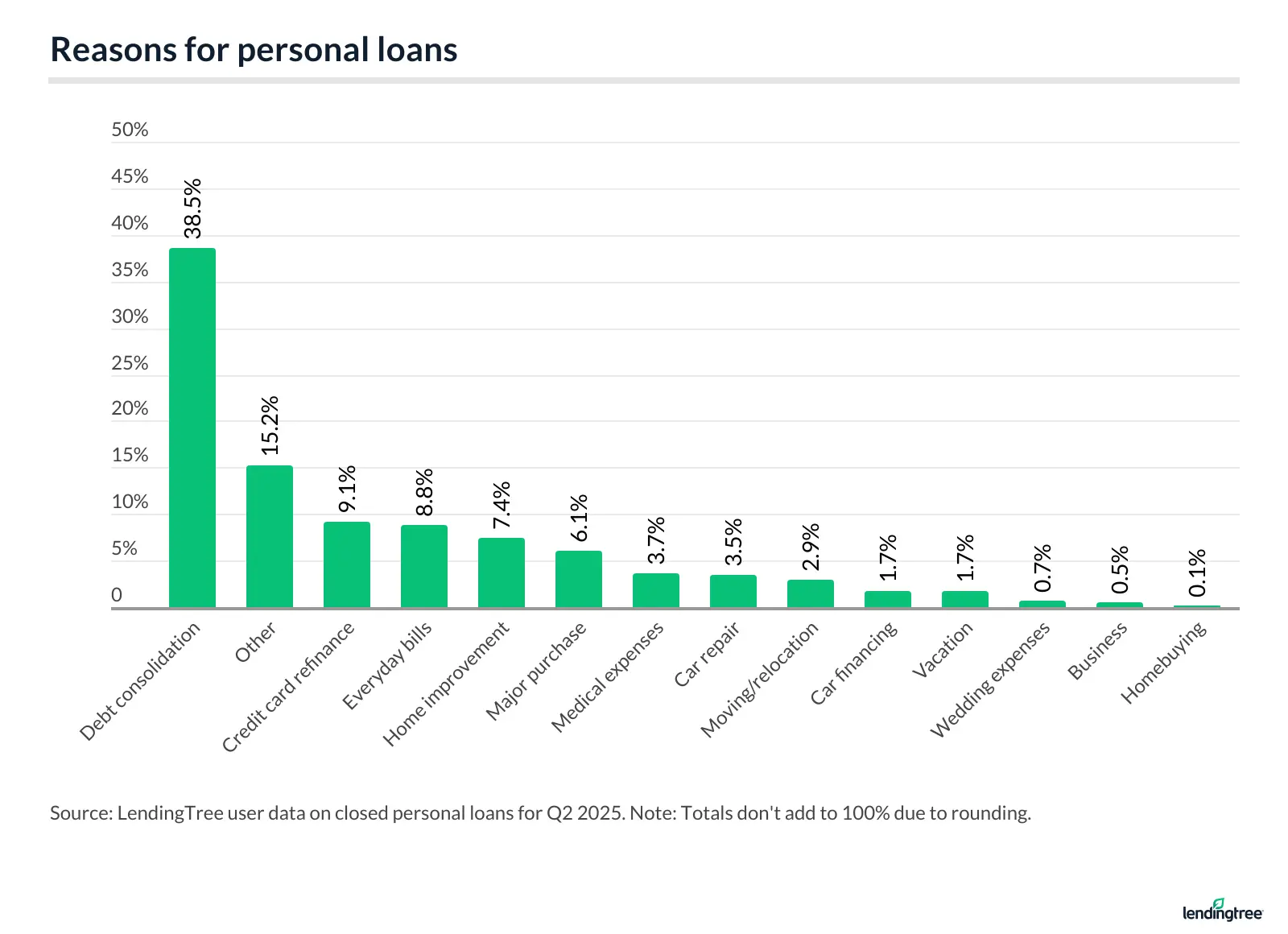
These personal loan statistics underscore the importance of borrowers exercising caution and wisdom when using this product.
Borrowers who use this product can come out ahead — but only if they weigh the decision, find a favorable personal loan and practice responsible debt management.
Expect personal loan debt to keep growing
Personal loan debt is growing, and that’s unlikely to change anytime soon. That’s because credit card debt is rising, too, and will likely continue to do so for the foreseeable future.
When that happens, people often turn to personal loans to help manage their credit card debt, and they can be effective tools for doing so. If you have really good credit, a 0% balance transfer credit card may be a better option for consolidating and refinancing other debts. Still, a personal loan can also be a strong option.
While balances will likely keep growing, interest rates likely won’t do the same. In September, the Federal Reserve cut interest rates for the first time in 2025, and further cuts are possible before the end of the year. Still, given the current uncertainty in the economy, any additional rate reduction is far from guaranteed.
Remember, it’s essential to understand that people don’t only take out personal loans when they’re struggling financially. Many people use them when remodeling their homes, starting a business, planning a wedding or vacation and making other big purchases. They do it because they feel financially secure enough to take on short-term debt. Despite many economic headwinds, there’s no question that millions of Americans feel that way today, and those folks will also help drive consumer demand for personal loans higher.
Add all this up, and personal loan growth will likely continue. Many folks will struggle with managing those loans. However, those who handle these loans well — especially those who use them to knock down their debt — can make a real difference in their financial situation, and that’s a big deal.
Sources
- TransUnion
- The Wall Street Journal
- Federal Reserve Bank of New York
- LendingTree
Get personal loan offers from up to 5 lenders in minutes
Read more
Personal Loan Requirements and How to Meet Them Updated January 3, 2024 A personal loan is a lump-sum installment loan that can be used for a variety…Read more
4 Risks of Taking Out a Personal Loan Updated February 28, 2023 Personal loans can save borrowers money through debt consolidation and give them access to needed…Read more

